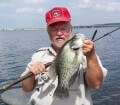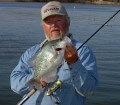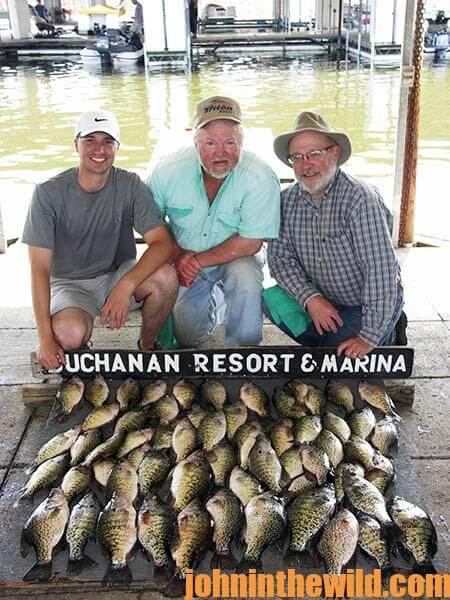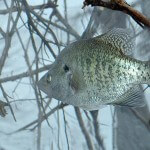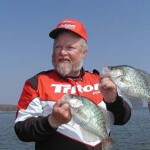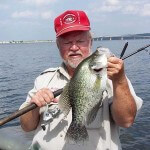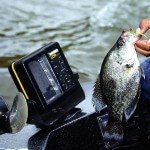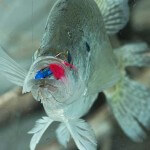John’s Note: 2014 is Steve McCadams’ 40th year of guiding crappie fishermen on Kentucky Lake. He also fished crappie tournaments for 10 years, and at one time he was part owner of Crappie USA. “I guess you could call me a crappie farmer, because I put out a lot of crappie cover and harvest a lot of crappie,” McCadams says. Except when he’s guiding or hunting ducks, McCadams guides crappie fishermen and catches crappie every day of the year. The secret for finding and catching crappie is to know where the crappie live and build homes for crappie. “I guide for crappie 9-10 months out of the year on Kentucky Lake, and we’ve never struck out,” McCadams reports. He only may catch 1-10 crappie, when he’s fishing an hour or two on the lake, because of high winds, snow, thunder or lightning. With two clients in the boat, McCadams averages keeping 40-45 crappie per day. On Kentucky Lake where he primarily fishes, anglers only can keep crappie 10-inches long or longer. However, on an average day, his clients may catch 100 crappie and release the undersized ones.
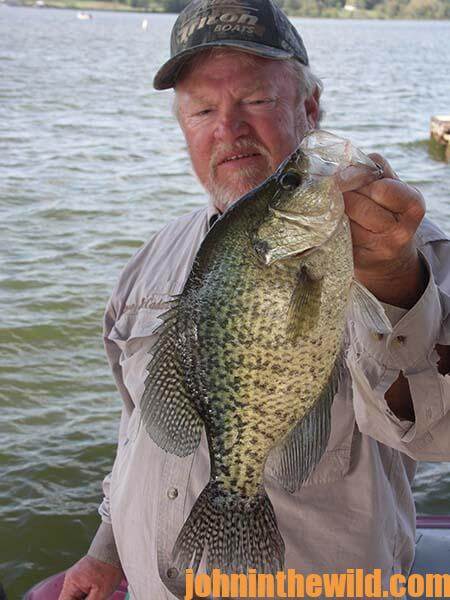 If I’m fishing muddy water, I’ll often use a green line or a golden-yellow line.
If I’m fishing muddy water, I’ll often use a green line or a golden-yellow line.
The crappie won’t be able to see the line as well, because of the stain of the water. Most of the time, I’ll use 6-8-pound-test clear Stren monofilament line. I know many crappie fishermen – more so in the North than in the South – will fish 2-4-pound-test line. But because we’re fishing in structure, I don’t want to break line all day long. If I’m fishing in clear water, I may get more bites fishing 2-4-pound-test line than I will with 6-8-pound-test line. But I don’t want to spend all my time during the day retying line for me and my customer.
Even if my anglers get hung in the structure, with 6-8 pound test line, I can bend one of those bronze-colored crappie hooks and pull it out of cover. I like using 6-8 pound test line, because all the other fish in Kentucky Lake don’t know I build my fish attractors especially for crappie. We catch big catfish out of our fish attractors, especially in warmer weather. Over the years, we’ve caught plenty of catfish that weigh 8-12 pounds.
When we’ve been fishing around stake beds, we’ve brought in cats that weigh 18-20 pounds. We’ve also caught some pretty good sized bass around these fish attractors. Especially during the summer months, we’ll catch a good number of 1-3 pound bass there. Occasionally, we’ll hook a bass that will weigh 5 pounds or more. With 2-4-pound-test line, we don’t have a prayer of landing catfish or bass in those stake beds and brush piles. But with the 6-8-pound-test line, we can land quite a few of these bigger fish that we really haven’t planned on catching.
Other Tackle: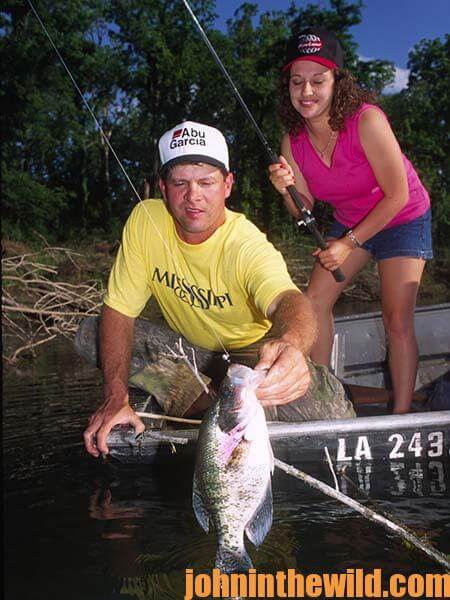
My customers and I primarily use 10-foot and 11-foot two-piece B’n’M crappie poles. I’m not a real big fan of the ultralight poles. I prefer a medium to a medium-heavy action pole. I like a light tip on a pole, but I want enough strength in that pole to pull a big crappie out of those fish attractors, before it gets hung-up. I like the two-piece rods in 10-11 foot lengths, since they’re easy to break down. I can store them in my rod locker, and they’re not nearly as clumsy to use and store as a one-piece pole. Two-piece rods are pretty much standard when you’re fishing with a pole that’s 10-11 foot long. The casting rods that I use for crappie fishing are 6-1/2- to 7-feet long. I like a longer spinning rod than a standard 6-foot rod, because you can cast light jigs farther with a rod that’s more than 6-foot long.
Most of the time, we’re fishing a 1/16-ounce jighead.
However, if the wind gets up, we’ll use a 1/8-ounce jighead. Some crappie fishermen fish jigs as light as 1/32-ounce. However, I like the 1/16-ounce jigs, because it still has a fairly-slow rate of fall. But if you’re casting, you can cast the 1/16-ounce jig farther than you can a 1/32-ounce jig. The 1/16-ounce jig also allows the fisherman to be able to feel his jig and feel the strike much better than a 1/32-ounce jig, especially if there’s any wind at all on the lake.
I prefer a hair skirt on my jig.
A hair skirt on a jig tends to hold fish scent or fish lure better than a plastic skirt does. However, I also like the freedom I have and the speed with which I can change colors with a tube jig. So, I fish both hair and tube jigs. Sometimes I try a solid body like a Bobby Garland jig (http://www.bobbygarlandcrappie.com). The crappie may prefer the solid body jig more than they do the tube jig. I keep several different types and various colors of jigs in my crappie tackle box at all times.
You never can tell what type or color of jig the crappie will prefer on the day you’re on the water.
If you want to consistently catch crappie, you have to be willing to adjust the baits you fish and the way you present those baits to the crappie. At times, crappie prefer a twister tail jig, and other times they’ll bite a solid-body jig more readily. So, I fish all different kinds of sizes and colors of jigs each day to try and determine what color, kind and size bait the crappie seem to prefer the most on any day I fish.
To learn much more about crappie fishing, get John E. Phillips’ Kindle eBooks and some print books, “Crappie: How to Catch Them Fall & Winter,” “Crappie: How to Catch Them Spring and Summer,” “Catch Cold Water Crappie Now,” and “Reelfoot Lake: How to Fish for Crappie, Bass, Bluegills and Catfish & Hunt for Ducks.” Click here to get these books.
Steve McCadams Professional Guide Service – stevemc@charter.net – (731) 642-0360
Share this page with a friend!
About the Author
John Phillips, winner of the 2012 Homer Circle Fishing Award for outstanding fishing writer by the American Sportfishing Association (ASA) and the Professional Outdoor Media Association (POMA), the 2008 Crossbow Communicator of the year and the 2007 Legendary Communicator chosen for induction into the National Fresh Water Hall of Fame, is a freelance writer (over 6,000 magazine articles for about 100 magazines and several thousand newspaper columns published), magazine editor, photographer for print media as well as industry catalogues (over 25,000 photos published), lecturer, outdoor consultant, marketing consultant, book author and daily internet content provider with an overview of the outdoors.

